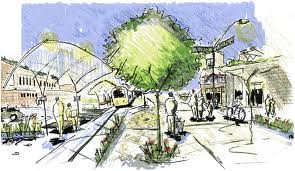Smart Growth = Better Bottom Line?
 This month the Center for Clean Air Policy released a study Growing Wealthier: Smart Growth, Climate Change and Prosperity which argues that “smart growth” can lead to economic gains by the private sector, governments, and local citizens . “Smart growth” describes development that reduces suburban sprawl, makes efficient use of public utilities, and fosters mixed-use and dense development patterns. Advocates aim to create communities where it is possible to walk or use alternative forms of transportation to meet daily needs.
This month the Center for Clean Air Policy released a study Growing Wealthier: Smart Growth, Climate Change and Prosperity which argues that “smart growth” can lead to economic gains by the private sector, governments, and local citizens . “Smart growth” describes development that reduces suburban sprawl, makes efficient use of public utilities, and fosters mixed-use and dense development patterns. Advocates aim to create communities where it is possible to walk or use alternative forms of transportation to meet daily needs.
Chuck Kooshian, principal author of the CCAP study, recently discussed these findings citing that smart growth-related developments, such as light rail stations, compact residential developments, and mixed residential and retail developments, have led to localized increases in property values, compared to other areas of the same city where these investments were not made. Beyond property value increases, Growing Wealthier also points to savings felt in smart growth by way of fuel costs and infrastructure costs, as well as increases in retail sales and tax revenues and induced private investment. Each of these economic benefits were shown to result from land use planning that discouraged sprawl, and created walkable, well-connected, and mixed use urban environments.
Kooshian also concludes that enabling smart growth is the responsibility of local planning departments. Currently, the zoning and land use codes of many municipalities do not allow many proven smart growth strategies, such as mixing residential densities on a single block and locating retail and shopping within walking distance of residential neighborhoods.
This study gives a strong argument for local governments to revisit their land use codes to see whether code changes could create smarter development standards. Smart growth advocates are also promoting the use of Leadership in Energy and Environmental Design (LEED) certification for neighborhood scale development and land use plans. LEED green building principals have been used since the early 1990s to guide construction of sustainably-built structures. The new LEED Neighborhood Development certification may provide a helpful guide to producing sustainably-built and economically successful communities.


No comments yet
Start the discussion by using the form below